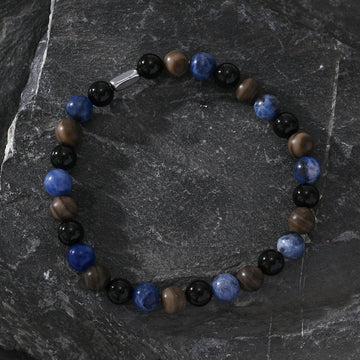The correct posture and gesture for wearing a stone bracelet should take into account comfort, safety and the protection of the accessory. The following are the specific steps and precautions:
First, preparations before wearing
Choose the appropriate size
Make sure the inner diameter of the bracelet is slightly larger than the thickest part of the wrist (usually by 1-2cm), to avoid it being too tight and pressing on the wrist or too loose and easily slipping off.
Open or hinged bracelets can be flexibly adjusted and are suitable for people with large variations in wrist size.
Clean your hands and bracelets
Clean your wrist with warm water and neutral hand sanitizer to avoid grease or dirt affecting your wearing.
Wipe the surface of the bracelet to ensure there is no dust or sharp objects to prevent skin scratches or damage to the gemstones.
Apply lubricant (optional)
When your wrist is thick or your bracelet is tight, you can apply a small amount of hand cream, soapy water or moisturizing oil to your wrist to reduce friction.
Second, wearing steps and gestures
Open-mouthed/loose-mouthed bracelets
Key points of gestures:
Two-handed coordination: Hold one end of the bracelet with one hand and the other with the other, maintaining even force.
Slow adjustment
Pull: Gently pull to both sides to avoid breaking due to unilateral force.
Pushing and closing: Align the bracelet with the thinnest part of the wrist (usually below the hand bones), and slowly push and close it to a comfortable position.
When wearing an open-type jade bracelet, you can first hold both ends, align the openings with your wrists, and then slowly push them together to avoid bumps.
2. Closed-mouth bracelet
Key points of gestures:
Wear vertically: Align the bracelet vertically with the thinnest part of your wrist to avoid getting stuck when applying force diagonally.
Rotating and sliding in: Slightly bend your wrist and slide the bracelet in by rotating to reduce friction.
When wearing a closed gold-inlaid jade bracelet, first align the bracelet vertically with your wrist, then gently rotate and slide it in to avoid pulling hard.
3. Elastic bracelet
Key points of gestures:
One-handed operation: Pinch both ends of the bracelet with your thumb and index finger, and stretch it out to a width where your wrist can easily slide in.
Uniform stretching: Avoid excessive stretching on one side to prevent the elastic rope from breaking.
When wearing an elastic crystal bracelet, you can hold both ends with both hands, spread it evenly and then slide it into your wrist.
Third, adjustments after wearing
Check comfort level
After wearing it, gently rotate the bracelet to ensure there is no sense of pressure or looseness.
For open-type bracelets, it is necessary to check whether the openings are aligned to avoid tilting.
Fixed clips (if applicable)
The hinged bracelet needs to be fastened with a snap to ensure it is secure.
For chain bracelets, the length of the chain needs to be adjusted to the appropriate position.
Avoid excessive pulling
Avoid frequent removal or forceful impact after wearing to prevent deformation or damage to the bracelet.
Fourth, common incorrect ways of wearing
Violent pulling: Forcibly pulling or pushing the bracelet may cause it to break or deform.
Unilateral force application: Applying force on one side of an open bracelet is prone to breakage.
Wearing diagonally: Closed-loop bracelets are prone to jamming when worn diagonally, increasing the difficulty of wearing them.
Excessive lubrication: Too much lubricant may cause the bracelet to slip or get dusty.
Fifth, daily maintenance suggestions
Regular cleaning: Wipe the surface of the bracelet with a soft cloth to prevent dirt accumulation.
Avoid collision: When wearing, avoid collision with hard objects to prevent scratches or cracks.
Proper storage: When not wearing, put the bracelet in the jewelry box to avoid squeezing or deformation.
Professional inspection: Regularly visit a jewelry store to check the firmness of the bracelet, especially the open type and the loose type.
By following the above steps and precautions, it can be ensured that the stone bracelet is comfortable and safe to wear, and its service life can be prolonged.







